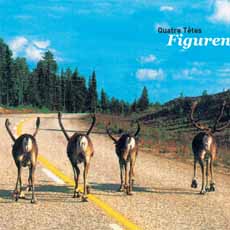
figuren
Susann Wehrli
Priska Walss
Claudia Ulla Binder
Gabriela Friedli
cs146
Music
can stir me, lull me, give me wings, annoy, relax, entertain, bore, change
my mood, fill me with energy....
The music of Quatre Têtes never leaves me unmoved; it always takes
me somewhere, right into it with enthusiam, with interest on the edge,
sceptical to a certain degree: It draws me directly into the conversations
of four abstract, very different characters, who inhabit a world full
of mysterious landscapes, bizarre spaces and surprising topography. As
though emerging from a novel by Stanislaw Lem, these beings change form
and shape; new languages are invented and later discarded, ambiguous gestures
remind one of earlier meanings, awaken dreamlike associations. I hear
the voices of animals whose bodies I can only guess at, I sway to curious
dances from other climatic zones, perceive charming moments of a folk
music quality, but fractured, alienated, disappearing just as quickly
as they surface.
Quatre Têtes is a utopian project: Four women – en-route together
since 2004 – playing music on the fringe of conventional listening
habits, associating freely on two grand pianos and several wind instruments,
of which the smallest would fit inside the largest a hundred times over.
From 440 strings, from alphorn, trombone, flute, melodica and piccolo
they explore the sounding bodies from outside and inside. They examine
the sound itself, its variability and power of expression, across melodiousness
and conventional patterns. They research material, figures und motives,
form und movement, static and dynamic, as each develops her own flow of
playing.
Although concepts are dispensed with, the main theme at play is the Duo:
two and two interchanging, two extended by two, dynamic interdependence
and its abrupt interruption, unity and conflict of two pairs in ever changing
association. This is no coincidence: originally two duos, – on the
one hand, the Duo Frappant with Gabriela Friedli and Priska Walss (recorded
on the CD „Intervista“, Intakt 087), and on the other, Claudia
Ulla Binder and Susann Wehrli – , meeting one another in a project
during „Zürcher Stadtsommer 2004“. Since then they have
worked together in close continuity.
Quatre Têtes – above all, are also four independent Musicians
in the contemporary music scene. Their paths in education - and further
training – as is often the case with women – do not necessarily
run in straight lines, but rather meander between studies and the practical,
jobs und further education. Indeed this may be significant in the formation
of such strong and contrasting characters.
Gabriela Friedli applies deliberate accents, mixes dark, idiosyncratic
colours and, with long breaths, devises large spreads of tension. She
is a master of the complex rhythm. From multiple overlying layers, tension
as well as directness is created: A movement, that at the same time is
both quick and slow can develop in all directions. Thus she always achieves
new possibilities of relationships and points of contact in the shared
playing ambience.
Claudia Ulla Binder, no less conscious of form, shows a great clarity
in the development of musical situations. She immerses herself with abandon
in the moment without losing the overview. As the reliable partner, she
brings coherence to the enterprise, in which role she acts quickly and
with precision. Researcher of the inside of the grand piano, she surprises
with alien, previously unheard sounds, that make the inclusion of electronics
completely unnecessary.
Susann Wehrli offers bewitching and varying sounds from different flutes,
that sometimes sound airy as a shakuhachi or a shepherd’s flute,
and then back to a clear balanced sound in the classical sense. She also
persuades with enthralling melody and an unbelievably relaxed playing
style. A clear lightness of being, which proves not to be superficial.
Priska Walss is the unpredictable one who, with emotional gestures, provides
increasingly surprising moments. She attacks, pauses, lays out dynamic
stresses, disrupts and lashes out in new directions. Thus she delights
with a very personal, dark, warm sound. Whether on the trombone or Alphorn,
she has her own language and, through her playing, develops and tells
narratives with a vocal quality.
15.1. 2009 Co Streiff